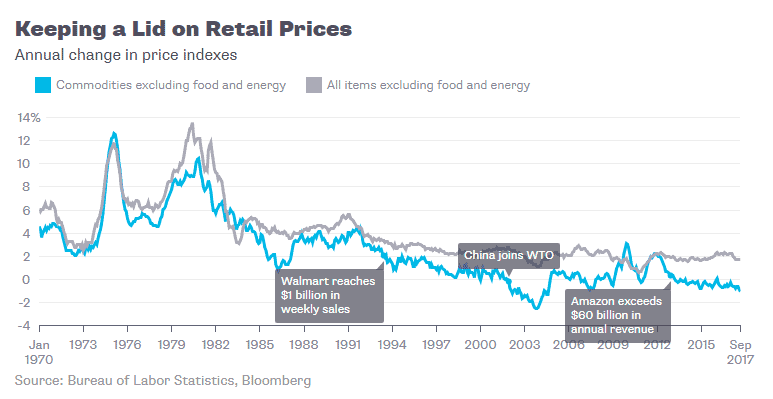Inflation in the US has been very low really since the mid-1990s. In fact, the Federal Reserve can’t seem to get inflation up to its 2% target -- a situation that Fed chair Janet Yellen has called a "mystery," as even pumping the economy with huge amounts of cash through bond purchases in recent years did nothing to get prices headed north.
It is possible that ecommerce generally, and Amazon specifically, are key factors in that weak change in US prices in recent years despite the stimulous?
That's one theory.
"Increasingly, economists are talking about the "Amazon effect." The idea is that as on-line retailers gain market share, they're putting pressure on brick-and-mortar shops to keep prices down," wrote a guest columnist on Bloomberg.com this week.
But it didn't start with Amazon. Twenty five years ago and lasting for many years there was similar talk about the "Walmart effect" on inflation, as the retail giant used low prices resulting from high levels of supply chain efficiencies to grow rapidly, pushing down prices for consumers for many years.
Add in China's entry into the World Trade Organization in 2002, and the Federal Rseserve has been battling several deflationary forces. See the intersting graphic below.

The latest U.S. inflation data offer some support for this idea.
"As of September, the price index for commodities excluding food and energy - a category including apparel, electronic goods and lots of other things that on-line retailers sell - was down a full percent from a year earlier," Bloomberg notes.
One thing is clear - other retailers wish the Amazon effect would come to an end, even if consumers can be thankful it is keeping a lid on higher prices for now.
Any Feedback on our Supply Chain Graphic of the Week? Let us know your thoughts at the Feedback section below.
Your Comments/Feedback
|